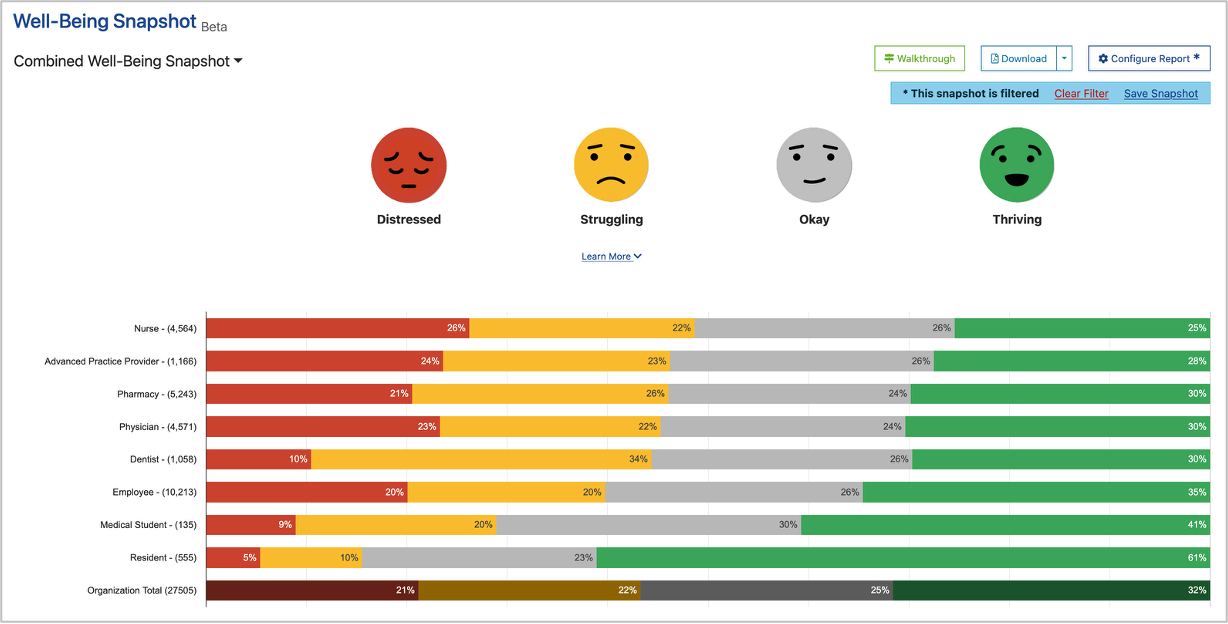Healthcare leaders bear a significant responsibility: ensuring the mental health and professional well-being of their clinical workforce. The stakes are high, and the need for a systematic, data-driven approach is paramount. By fostering a culture of wellness, leaders can not only enhance patient care but also improve job satisfaction and retention among healthcare professionals. Here are four essential steps to guide you in understanding and promoting the well-being of your team.
1. Uncover the Drivers of Employee Distress
To effectively address employee well-being, leaders must start by understanding the root causes of distress. Measurement with a validated assessment is critical because it provides objective, actionable insights into the factors contributing to stress, burnout, and dissatisfaction. Without reliable data, it’s impossible to identify underlying problems or determine the effectiveness of interventions.
Validated assessments also allow for ongoing evaluation, which is essential to track trends and adapt interventions over time. For instance, longitudinal data can reveal shifts in employee distress levels, such as an increase in stress during peak patient volumes or the effectiveness of implemented resources. Research published in The Journal of Occupational Health Psychology supports the notion that consistent measurement is foundational to effective workplace well-being programs; organizations that measure well-being regularly report a 25% improvement in staff morale and a 20% reduction in burnout compared to those without systematic assessment practices.
Simply put, you can’t fix what you don’t measure. Relying on validated tools ensures that the organization has a clear, evidence-based picture of its workforce’s needs, making it possible to prioritize resources and tailor interventions where they are needed most.
Key Insight: The Well-Being Index can help uncover various distress factors, providing a holistic view of your team’s mental health. This comprehensive approach allows for targeted interventions that address specific issues.
[RELATED: Economic Cost of Burnout Guide – The business case for investing in clinician well-being]
2. Discover the Groups Most in Need of Support
Not all healthcare workers experience distress equally, and identifying which groups are most vulnerable is essential for targeted support. Real-time analytics and benchmarking, powered by validated well-being assessments, enable leaders to pinpoint high-risk populations within their teams. For example, the State of Well-Being 2023 report revealed that younger clinicians and those in high-pressure specialties, such as emergency medicine and intensive care, consistently report higher levels of distress, with burnout rates exceeding 55% in these groups. Female healthcare professionals, who often juggle dual caregiving responsibilities, were also found to experience disproportionately high levels of stress and emotional exhaustion.
By using segmented data, leaders can identify these trends early and allocate resources where they will have the greatest impact. For instance, interventions tailored to younger staff might focus on mentorship and professional growth opportunities, while those for female clinicians might emphasize flexible scheduling and enhanced childcare support. Organizations that leverage such insights are better equipped to provide timely, targeted assistance, reducing burnout and improving overall team well-being.
Strategy: Utilize demographic data and job role information to identify vulnerable groups within your organization. Implement wellness platforms such as the Well-Being Index that offer real-time data and benchmarks against industry standards. This approach ensures that resources are allocated efficiently and that interventions are designed to meet the specific needs of those most at risk.
[CASE STUDY: Creating a New Wellness Culture in a 21-State Health System]
3. Develop and Implement a Data-Backed Action Plan
Every organization has unique challenges, cultural dynamics, and workforce needs, making a one-size-fits-all approach to well-being ineffective. Developing an actionable, data-backed plan tailored to your specific circumstances is essential for driving meaningful change. This process starts with consulting an experienced organizational well-being strategist. These experts can help assess your specific areas of need, evaluate your organization’s readiness for change, and determine your ability to implement sustainable interventions.
For example, a small rural hospital might prioritize strategies to combat clinician isolation and limited access to mental health resources, while a large urban health system might focus on streamlining workflows to reduce administrative burden. A well-being strategist can connect your organization with proven, evidence-based frameworks customized to your unique context. These frameworks incorporate interventions supported by research, such as peer support programs and workload optimization, which have been shown to reduce burnout.
Key Insight: By leveraging tailored strategies and validated frameworks, healthcare leaders can confidently address the specific stressors impacting their teams, fostering a workplace culture where well-being thrives. This strategic approach not only ensures effective implementation but also positions organizations to achieve long-term improvements in staff satisfaction, retention, and patient outcomes.
[RELATED: Organizational Wellness Structure Roadmap – A visual guide to help organize your teams]
4. Measure the Effectiveness of Your Initiatives Over Time
Implementing well-being initiatives is only the beginning—measuring their effectiveness over time is what ensures lasting impact. Regular assessment allows leaders to determine whether interventions are achieving desired outcomes and to make data-driven adjustments as needed.
However, measurement isn’t just about numbers; it’s about generating actionable insights. This is where partnering with an experienced team of well-being experts is invaluable. Our strategists can help design systems for tracking progress, provide benchmarking data to compare against industry standards, and ensure your initiatives align with best practices.
Key Insight: The process of ongoing measurement does more than ensure accountability—it builds a culture of trust and transparency. When staff see that their feedback leads to tangible improvements, engagement grows, and your well-being efforts gain credibility. Regularly revisiting and refining your strategy ensures it evolves to meet the changing needs of your workforce, driving sustainable improvements in both employee well-being and organizational performance.
Promoting Professional Well-Being
Promoting the mental health and well-being of healthcare professionals requires a systematic, data-driven approach. By uncovering the drivers of distress, identifying those most in need of support, developing a comprehensive action plan, and measuring the effectiveness of your initiatives, healthcare leaders can create a sustainable culture of wellness. This not only benefits the clinical workforce but ultimately enhances patient care and organizational performance.







